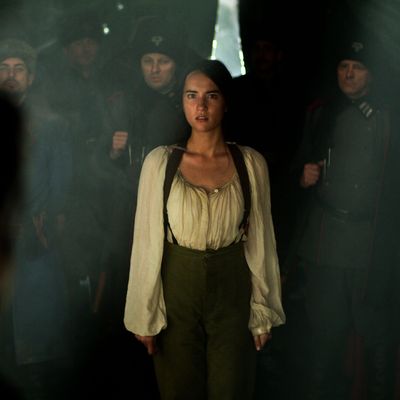
Shadow and Bone is a show that lives up to its name. There are many shadows, and there are definitely bones. Based on the popular YA novel of the same time, the new Netflix series has some bones that show up as a key plot point late in the series, but until that point the shadows are everywhere. The show is often plunged into an inky magical blackness, rendering it scary and mysterious while also being pretty hard to follow. Someone definitely pushed someone else off a boat, but who? Is that lady in a cape and fur collar standing in the glowering dimness the same as the previous lady we saw in a cape and fur collar, or is this a different one?
The darkness is the series’ key world-building device: It’s a massive chasm of Stygian fog called the Shadow Fold (a.k.a., The Unsea) that splits the fantasy world’s map into distant nations. Navigating through it involves treacherous hours on a land-boat-thing and crossing your fingers that the monsters who live there eat someone else in your party. It’s magic; bad magic. The show’s heroine Alina Starkov (Jessie Mei Li) has a secret capacity for very special, good magic. There is also a bad not-quite boyfriend character and a good not-quite boyfriend character, although revealing who is who is a bit of a spoiler.
Shadow and Bone is both defined and hampered by endless exposition about the details of how this world’s magic works, beginning with the existence of the Shadow Fold and then continuing with a lengthy explanation of all the magical systems. People who can use magic are called Grisha, but there are a dozen different flavors of Grisha and a long history of anti-Grisha sentiment that makes them both powerful and feared. There’s also big magic and small magic, and some kinds of Grisha that are special beyond just the regular Grisha-ness. For every line intended to clarify how it all works, Shadow and Bone seems to accidentally do the opposite. It dunks viewers into its scary, volcra-infested world (volcra are monsters!) and repeatedly points out, even several episodes in, all the stuff that it still needs to explain.
To book readers, I assume all of this will be much more legible, and all the ins and outs of the Grishaverse will feel like a natural part of the show’s world. Although the TV series is pretty faithful to the story of Alina and her childhood friend Mal (Archie Renaux), book readers will notice that the TV adaptation folds in an entirely new plotline from elsewhere in Leigh Bardugo’s Grisha books. A plot about a group of extra-legal ruffians, and another about a captured Grisha witch and her grumpy captor, have been ported in from Bardugo’s Six of Crows and woven together with Alina and Mal’s story from Shadow and Bone.
I can understand the desire to build out Alina and Mal’s arc in the TV series. It’s clear that the Grishaverse is spread across a broad map, and the influence of Game of Thrones has meant that on TV, fantasy stories tend to be geographically big, with many interwoven stories and characters moving toward and away from one another across a large, politically complex map. The introduction of the Six of Crows characters takes Shadow and Bone’s triangular character structure and turns it into a many-sided die.
Eventually, when all, or at least most, of the characters come together in various formations late in the series, Shadow and Bone’s design does make some sense. Six of Crows characters like Jesper (Kit Young), Inej (Amita Suman), and Kaz (Freddy Carter) help with the tone, puncturing the darkness with some wisecracks and relationships with elements outside of just “hatred” or “intense longing.” There are some effective moments when Alina, Mal, and the mysterious General Kirigan (Ben Barnes) are engaged in some high-stakes something or other, while Kaz and his band sneak around in the hallways and basements on the edges, waiting for their chance to pounce.
But it is a slog to get to that point, and the series is not well-crafted enough to jump nimbly from one story line to another without immediately losing track of why audiences should care about this other plotline. It takes time for Kaz, et. al., to gel into a fun, functional group, and the period spent waiting for them all to get on the same page is a dull, dense, and occasionally incomprehensible muddle.
Shadow and Bone is at its best when it is small and fun, which is what does eventually happen with the Kaz story, or when it’s big and clear, which is territory Alina eventually arrives in once the show gets around to the part where everyone’s hunting for a big mythical stag. (Many fantasy stories on shaky ground can squeeze a lot of juice out of a mythical stag, and Shadow and Bone is no exception.) Unfortunately, a lot of the series falls into neither of those categories, especially early on. More than once I found myself wishing it would just stay in one place, with no flashbacks or story-within-a-story distractions. I wanted to hope that things turned out all right for Alina, or that Kaz could figure out his little criminal enterprise, but the show kept interrupting me every time my affection for them gained any steam. And often, by the time Shadow and Bone returned to those stories, there’d be at least some small time jump, making everything feel even more discombobulated and unmoored from everything else.
Still, Shadow and Bone does mostly manage to pull it all together in the end, and the mythical stag is very shiny and nice-looking. That might be enough to make it a fun, diverting series, especially among fans of the books or anyone looking for something with a lot of fur-trimmed clothing and hand-waving magic. Just give your eyes time to adjust to the gloom.


